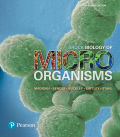
EBK BROCK BIOLOGY OF MICROORGANISMS
15th Edition
ISBN: 8220103633352
Author: Stahl
Publisher: PEARSON
expand_more
expand_more
format_list_bulleted
Question
Chapter 1.5, Problem 1CR
Summary Introduction
Microscope is a fundamental tool used to study the size and shape of the microorganisms. It magnifies the cell size and other smaller objects. In order to visualize microorganisms, the microscopes are the right choice to view their size and shape of the cells. A typical microscope consists of an eyepiece, objective lens, and light illuminator to visualize the cells or small objects with good magnification and resolution abilities.
Expert Solution & Answer
Want to see the full answer?
Check out a sample textbook solution
Students have asked these similar questions
In spectrophotometry, what is the role of the green background in the set-up? What does it represent in the actual spectrophotometer?
Define each of the following terms:
A) What is resolution and how is resolution related to the wavelength of light used to illuminate the sample?
B) What is the magnification of the specimen if you are using a 40x objective and a 10x eyepiece?
C) How is the numerical aperture (NA) of a lens related to its ability to gather light from a specimen?
Can colorless samples be analyzed using a UV-Vis spectrophotometer? Yes or No or Maybe?
Chapter 1 Solutions
EBK BROCK BIOLOGY OF MICROORGANISMS
Ch. 1.1 - In what ways are microorganisms important to...Ch. 1.1 - Why are microbial cells useful for understanding...Ch. 1.1 - What is a microbial colony and how is one formed?Ch. 1.1 - What are bacterial colonies and how are they...Ch. 1.2 - What structures are universal to all types of...Ch. 1.2 - Prob. 2MQCh. 1.2 - What structures can be used to distinguish between...Ch. 1.2 - Prob. 1CRCh. 1.3 - How old is Earth and when did cells first appear...Ch. 1.3 - Prob. 2MQ
Ch. 1.3 - Why were cyanobacteria so important in the...Ch. 1.3 - Prob. 1CRCh. 1.4 - Prob. 1MQCh. 1.4 - Prob. 2MQCh. 1.4 - Prob. 3MQCh. 1.4 - Prob. 1CRCh. 1.5 - Define the terms magnification and resolution.Ch. 1.5 - Prob. 2MQCh. 1.5 - Prob. 1CRCh. 1.6 - Prob. 1MQCh. 1.6 - Prob. 2MQCh. 1.6 - How can cells be made to fluoresce?Ch. 1.6 - Prob. 1CRCh. 1.7 - Prob. 1MQCh. 1.7 - Prob. 2MQCh. 1.7 - Prob. 1CRCh. 1.8 - Prob. 1MQCh. 1.8 - Prob. 2MQCh. 1.8 - Prob. 1CRCh. 1.9 - Prob. 1MQCh. 1.9 - Prob. 2MQCh. 1.9 - Besides ending the controversy over spontaneous...Ch. 1.9 - Explain the principle behind the Pasteur flask in...Ch. 1.10 - How do Kochs postulates ensure that cause and...Ch. 1.10 - What advantages do solid media offer for the...Ch. 1.10 - Prob. 3MQCh. 1.10 - Prob. 1CRCh. 1.11 - What is meant by the term enrichment culture?Ch. 1.11 - Prob. 2MQCh. 1.11 - What were the major microbiological interests of...Ch. 1.12 - Describe the experiments that proved DNA was the...Ch. 1.12 - Why are microbial cells useful tools for basic...Ch. 1.12 - Describe the experiments that proved DNA to be the...Ch. 1.13 - What kinds of evidence support the three-domain...Ch. 1.13 - What is a phylogenetic tree?Ch. 1.13 - List three reasons why rRNA genes are suitable for...Ch. 1.13 - What insights led to the reconstruction of the...Ch. 1.14 - How are viruses different from Bacteria, Archaea,...Ch. 1.14 - What four bacterial phyla contain the most...Ch. 1.14 - Prob. 3MQCh. 1.14 - What features (or lack of features) can be used to...Ch. 1 - Pasteurs experiments on spontaneous generation...Ch. 1 - Describe the lines of proof Robert Koch used to...Ch. 1 - Imagine that all microorganisms suddenly...
Knowledge Booster
Similar questions
- What is the principle behind a UV-Vis spectrophotometer, and what are its key components, and how does it work?arrow_forwardExplain the difference between resolution and magnification.arrow_forwardContrast how the views differ under high power (40x) and oil immerson (100x) objective lenses in terms of a) magnification b) detail of the cell, c) size of the area being viewed and d) resolution.arrow_forward
- The field of view (FOV) is the entire circular image we see when looking into the eyepiece. The diameter of the FOV gets smaller as we increase magnification. It can be measured by using a stage micrometer like a ruler, measuring from edge to edge. Notice that the stage micrometer is 1000 microns (µm) in length, and the field of view under the lowest magnification is 5000 µm. Describe how we measure it?arrow_forwardWhat is the difference between low reolution and high resolution?arrow_forwardWhat is the final magnification that you would obtain if you were viewing an object through a microscope with a 40X objective lens and a 25.5X ocular lens?arrow_forward
- Which of the following is true about the relationship between depth of field and magnification? There is no relationship. When magnification increases, depth of field decreases. When magnification increases, depth of field increases. Stereomicroscopes offer a lesser depth of field than compound microscopes. The depth of field of a microscope determines how much magnification it can achieve.arrow_forwardWhen using a microscope, does the depth of focus decrease or increase with increasing magnification?arrow_forwardHow does differential interference contrastmicroscopy differ from bright-field microscopy?arrow_forward
- What is phase contrast? Give examples of phase contrast in optical microscopy.arrow_forwardWhat advantage do fluorescent dyes and fluorescence microscopy provide in comparison to the chemical dyes used to stain specimens for light microscopy?arrow_forwardWhat are the light sources used in UV-vis spectrophotometry.arrow_forward
arrow_back_ios
SEE MORE QUESTIONS
arrow_forward_ios
Recommended textbooks for you
 Principles Of Radiographic Imaging: An Art And A ...Health & NutritionISBN:9781337711067Author:Richard R. Carlton, Arlene M. Adler, Vesna BalacPublisher:Cengage Learning
Principles Of Radiographic Imaging: An Art And A ...Health & NutritionISBN:9781337711067Author:Richard R. Carlton, Arlene M. Adler, Vesna BalacPublisher:Cengage Learning

Principles Of Radiographic Imaging: An Art And A ...
Health & Nutrition
ISBN:9781337711067
Author:Richard R. Carlton, Arlene M. Adler, Vesna Balac
Publisher:Cengage Learning
